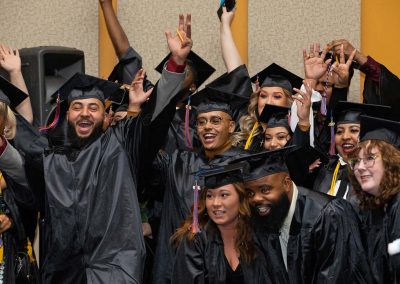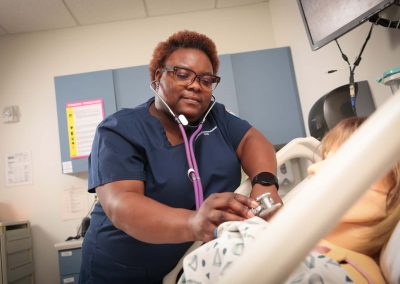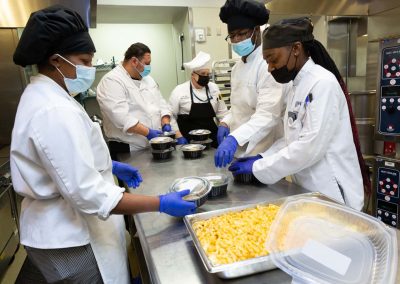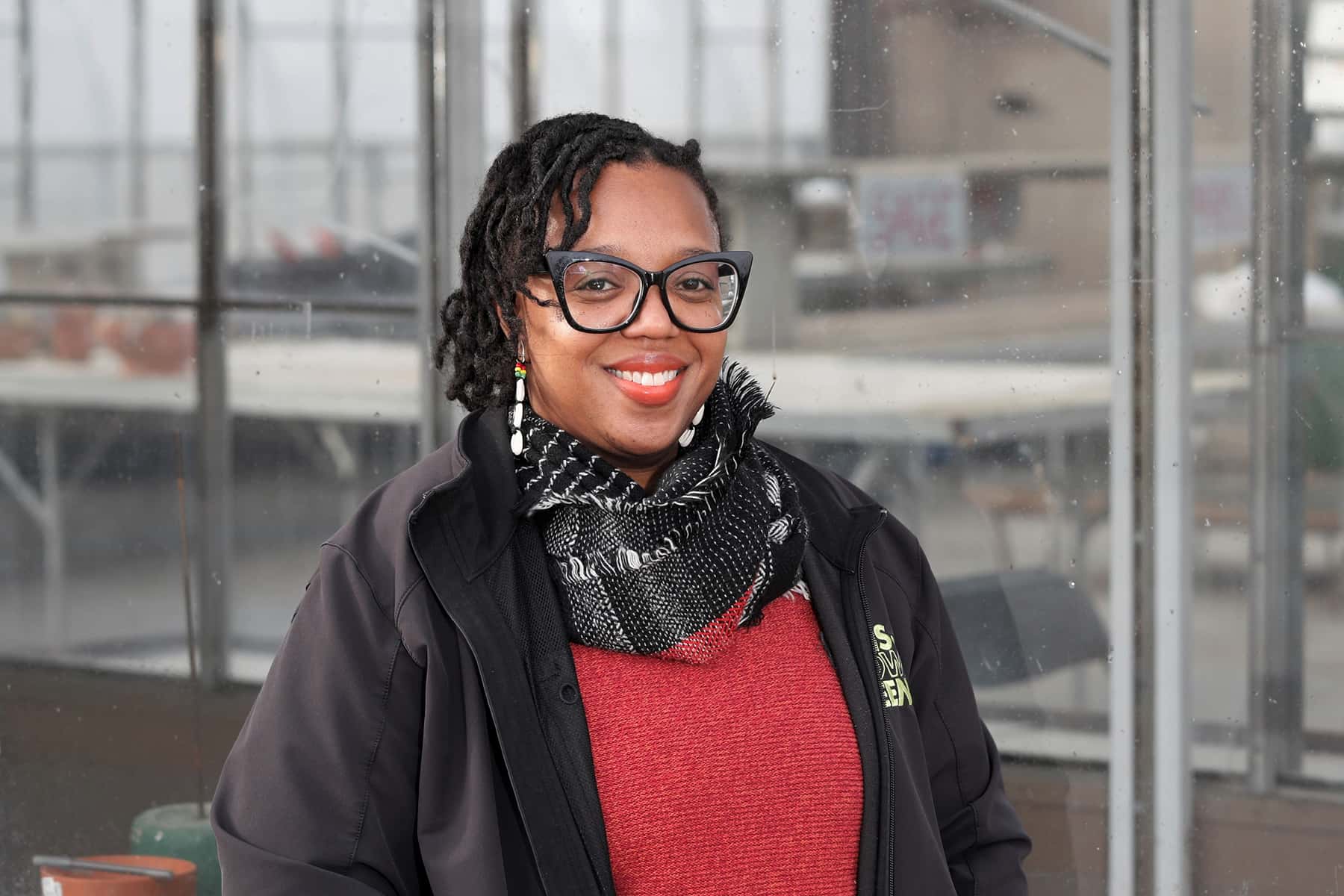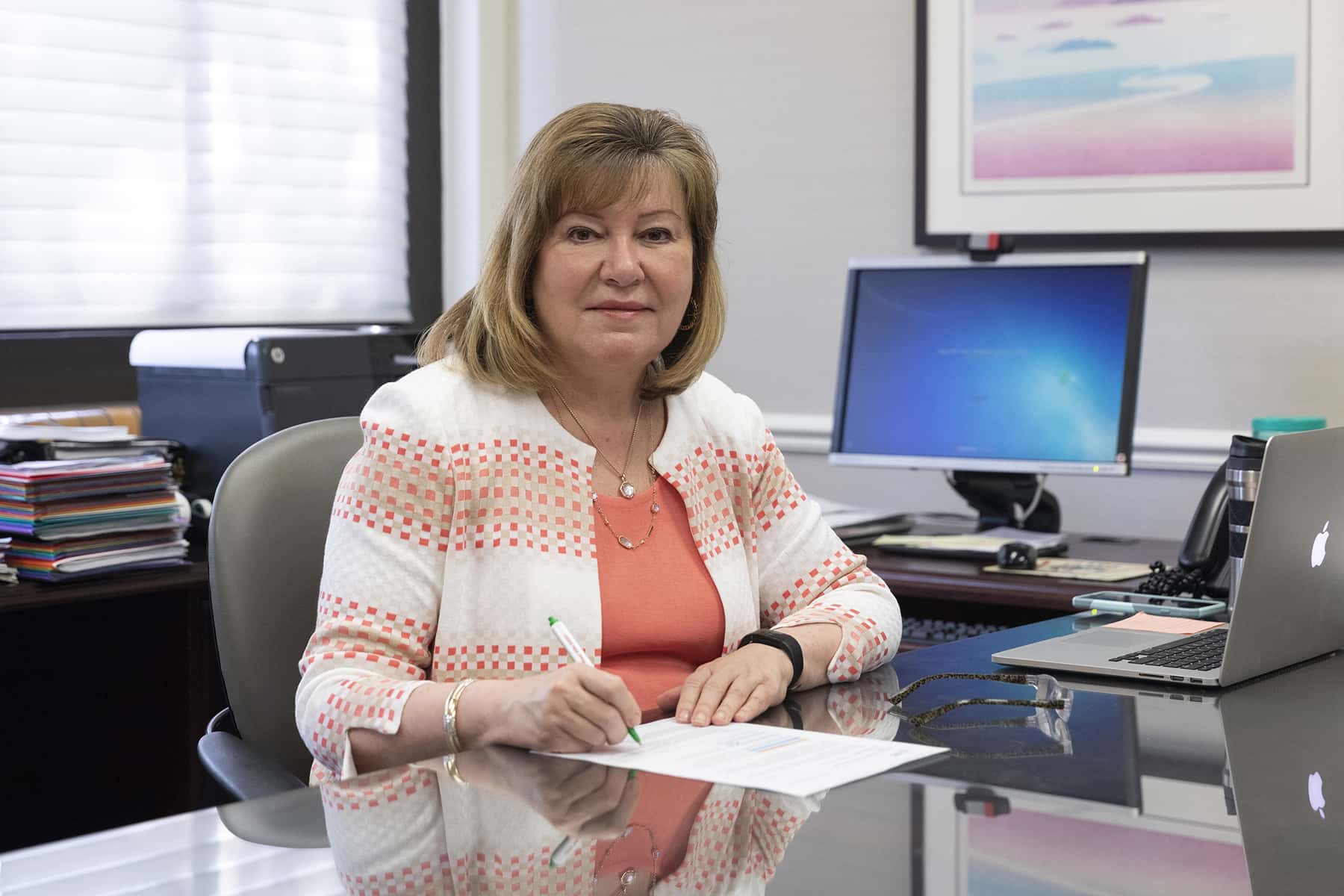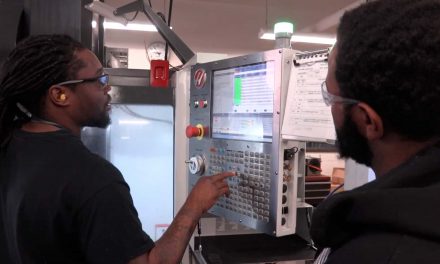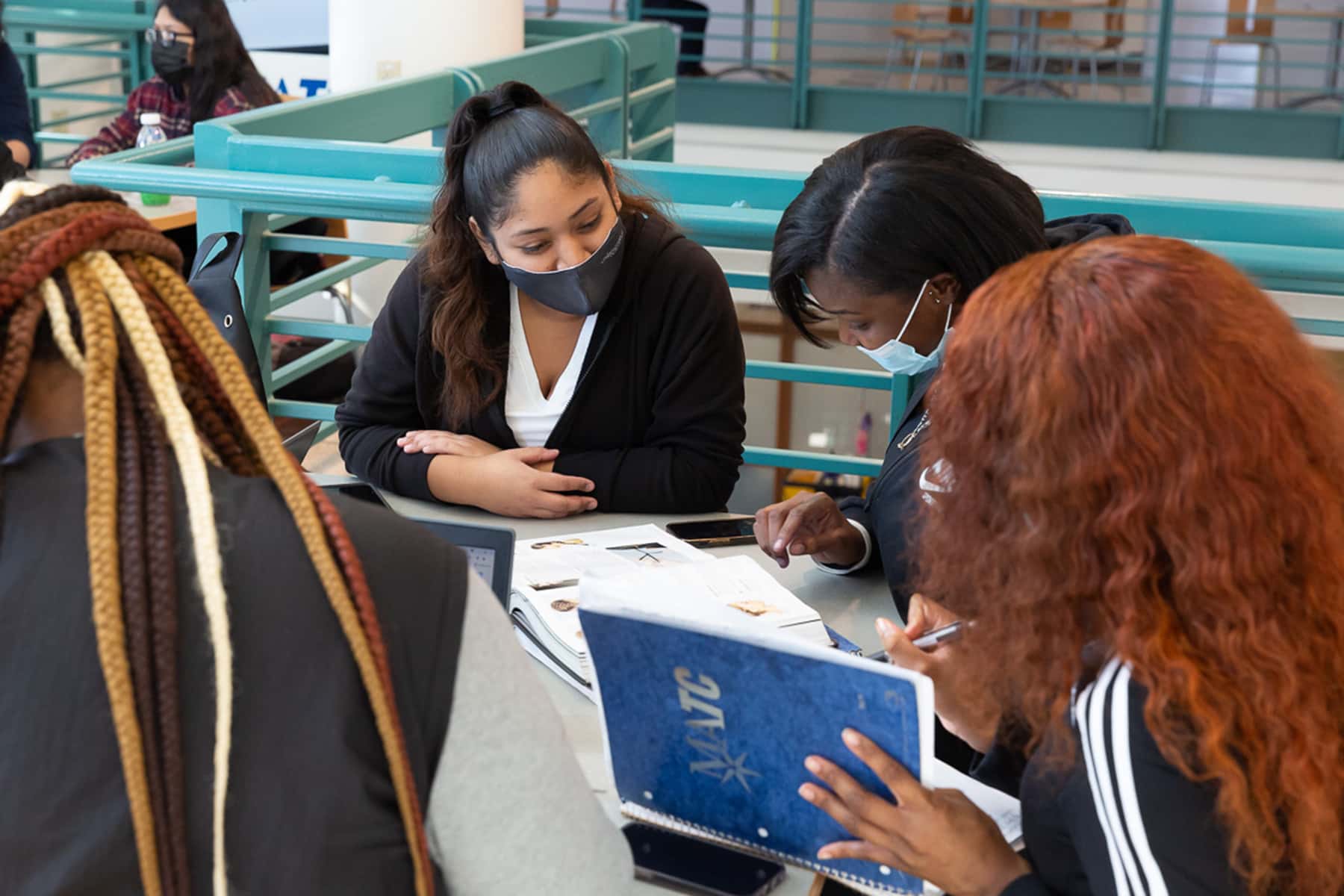
MATC offers 200 programs that can help prepare students for careers in one or two years and provides a more affordable avenue for students who transfer to other schools to pursue four-year degrees.
Jasmin Treske had planned to go to college after graduating from South Milwaukee High School. She picked out classes at the University of Wisconsin-Milwaukee and attended orientation, but the looming financial commitment spooked her. So she decided to take a year off. And in that year, Treske got pregnant.
“Going to school just became that much harder. Now somebody else was in the equation,” she said.
Treske worked retail jobs and the first shift at a hotel, but a newborn made the hours difficult to manage. She hoped for something more — a career and financial stability, for the baby and for her.
One day, without a plan, she stopped by the Oak Creek Campus of Milwaukee Area Technical College and started scouring the rack of informational brochures. That’s where a staff member spotted her and asked if she needed help. She did. Her parents hadn’t been to college; she had to navigate a new world of higher education without a template.
Soon Treske was meeting with an admissions counselor and student success coordinator. “They helped me answer questions I didn’t know to ask,” she said.
Not long after, Treske began taking classes in finance. A part-time job as a bank teller became full-time, and she started volunteering, teaching financial classes to young people. Treske met a mentor, and her professional network quickly expanded.
Today, Treske is the program and events manager for the MKE Tech Hub Coalition, a nonprofit that aims to grow and diversify Milwaukee’s tech community. She’s an active supporter of MATC. Treske, who is Latina, helps connect other young people of color to tech careers.
‘Determined to be part of the solution’
Across the country, community colleges are looked at as a ladder to opportunities for people like Treske, educating students, launching careers and fueling local economies.
In Milwaukee, that mission is increasingly vital, particularly for its residents of color. A 2020 UW-Milwaukee report ranks it at or near the bottom of major cities when it comes to many key measures of Black community well-being, including rates of homeownership and employment. The fallout from the COVID-19 pandemic is only expected to deepen inequities.
MATC has in recent years launched a dizzying array of programs and initiatives to open the door to adult learners, including free tuition to qualifying students, debt forgiveness and dual-credit programs for high school students which it says have cut costs and accelerated a college education for more than 4,000 students. More than three-quarters of participants in the free tuition and debt forgiveness programs are students of color, MATC said.
Despite successes, former students and those who have worked with them say barriers persist for adult learners transitioning to college. Fewer MATC students complete their programs than at peer institutions across the United States, according to the Integrated Postsecondary Education Data System. About 16% of MATC students finish their programs within 150% of normal completion time, compared to a median of 31% among peer institutions.
Others raised concern over what they see as opaque measures used to tout the accomplishments of one key program known as M3 or M-cubed, which seeks to seamlessly transition students between Milwaukee Public Schools, MATC and the UW-Milwaukee. Nevertheless, MATC remains a lifeline for students like Treske, boosting economic opportunity for Milwaukee and its residents.
“I really am a true believer that education really lifts people out of poverty, improves their lives and improves the community that we all share. And we’re determined to be part of that solution,” MATC president Vicki Martin said.
As the largest and most diverse campus within the Wisconsin Technical College System, MATC is well positioned for the effort. At four different campuses and two smaller education centers, the tech college enrolled more than 24,600 students last year — 90% of them part-time — for a full-time equivalent of roughly 8,000 students, according to the most recent data available. More than a quarter of its students are Black and 20% Latino. Statewide, Black students make up 6.5% and Latinos make up 9% of technical school enrollment.
Milwaukee: ‘Archetype’ of inequality
Fifty years ago, Milwaukee was a place of promise — a destination for Black and immigrant laborers who found work at any number of tanneries, manufacturing plants and breweries that made the city famous.
By the late 1970s, however, the jobs that once provided a pipeline to the middle class had started moving to the suburbs, and later, overseas. Unemployment soared, particularly for Black residents living in the city’s core, where many had been forced to live due to restrictive housing covenants and federal red-lining practices that denied loans to prospective Black homeowners based on perceived financial risks. Milwaukee has one of the lowest Black homeownership rates among major U.S. cities at just 26% — one-third of the rate of white homeownership.
By some measures, the outlook for Black Milwaukeeans has only worsened in recent decades. A 2020 report by UW-Milwaukee’s Center for Economic Development described the city as “the archetype of modern-day metropolitan racial apartheid and inequality.”
According to the report, Milwaukee remains one of the nation’s most segregated cities, where the median income of Black households is lower than any other of the nation’s largest 50 metro areas. The poverty rate of Black residents is highest in Milwaukee among those cities and nearly five times the rate of white Milwaukee residents. Only Minneapolis has a lower rate of Black homeownership.
Martin said such statistics only underscore the importance of education as a tool for unlocking economic opportunity — both for students transitioning from high school, as well as the working adults who make up most of its student body.
“The kinds of jobs and careers that we offer will lead to family sustaining wages,” Martin said. “And I really believe that education is that difference maker.”
MATC points to evidence that the institution is helping lift up all students, including those of color.
A 2018 report from Emsi, a labor market analytics firm, said students, alumni and the institution itself generate $1.5 billion each year by raising graduates’ earning potential, creating skilled workers for in-demand jobs and employing more than 2,000 full-time faculty and staff.
Pandemic accelerates enrollment drop
But as it has for colleges across the country, the past year and a half have tested MATC’s capacity to sustain revenues and meet students’ needs amid a pandemic — the fallout of which has yet to come into full view.
COVID-19, and the declining revenue from lost enrollment, posed an existential threat to institutions across the county. MATC was not immune.
Data from the current year are not yet available, but enrollment across the technical college system dropped by 19% between 2018 and 2020. For MATC, its full-time equivalent count of students dipped from 10,023 to 8,021 over the same period.
When the technical college surveyed students who left school between the spring and fall of 2021, they learned from the 500 students who responded that changes in life circumstances, funding or concerns over physical and mental health were among the top reasons students did not return this past fall.
Martin said MATC maintained a balanced budget by reducing expenditures, cutting the number of course sections offered — but not classes or programs.
Students still need credentials, Martin said, and employers still need skilled workers. Those demands haven’t changed. And the lessons learned during the pandemic will only make the institution better, she said.
“I think it’s given us an opportunity to really look at everything a lot differently than we did before,” Martin said. “And I think we’re a lot stronger because we have more tools in our toolkit.”
Success uneven for MATC students
There’s no shortage of success stories for MATC graduates. Wisconsin Watch reached out to current and former MATC students via Facebook and text messages through its News414 engagement collaboration, asking if the institution helped them move toward their goals. Most who responded shared positive stories.
After dropping out of high school, Marisol Mendoza earned an associate’s paralegal degree from MATC. Based on her grades there, she was awarded scholarships to Marquette University, where she studied criminology and legal studies. Today, Mendoza’s work as a paralegal focuses on civil rights and labor law.
Tanya Fenninger said MATC helped her become a certified nursing assistant, a credential that got her a job right out of school.
“I think MATC does a great job at getting you prepared for a professional career,” she said.
Others shared experiences they said left them disappointed.
Melissa Buscher had been a hairdresser for 30 years when she decided it was time for change. She wanted more traditional hours, and owing to an autoimmune disorder that put her at greater risk of complications from COVID-19, a safer work environment. So in August 2020, at the age of 47, she enrolled in MATC, planning to join its echocardiography program.
But she soon found out she’d need additional classes before she could apply for the program. She took chemistry, struggling through online lectures with YouTube videos in place of hands-on activities. When she struggled, she emailed questions to the instructor, she said, but he often lagged in responding.
Buscher described the instructors as overwhelmed. “They had too many hats to wear,” she said.
The next semester, in microbiology, she said she fell just short of the grade she needed for her program, and the instructor made no allowances for the communication gaps that come with online learning. One year and $9,000 later, she left the school, transferring to Bryant & Stratton College. She said the credits she earned at MATC won’t count toward the credential she’s currently pursuing.
Martin said both students and staff faced a learning curve when it came to the online instruction, with staff constantly responding to challenges as they arose. Over time, she said, instructors and students generally became more comfortable with virtual learning, and some students found they actually preferred the online approach due to its flexibility.
As for Buscher, the experience wasn’t all bad. She particularly enjoyed her psychology and English classes, calling the episode a “learning experience.”
“I’m a firm believer that everything happens for a reason,” Buscher said. “I don’t hold any grudges. I wish that some of the debt that I incurred could fall off, but it is what it is.”
Adriana Vazquez is an educator who works for a community-based organization that supports adults working toward their high school equivalency degrees. Speaking for herself and not her organization, Vazquez called MATC a crucial partner, providing instructors plus resources at low or no cost.
But Vazquez noted that some instructors are less skilled than others. And in conversations with students who transition to MATC, she’s heard many say they didn’t understand financial terms before they enrolled. In other cases, daily circumstances like lack of transportation can pose barriers.
MATC provides free bus passes to students taking six or more credits. But indirect bus routes are overwhelming to some students, while others worry about sitting on public transportation amidst a pandemic, she said.
Vazquez is hopeful that MATC’s plan to offer more services at community-based organizations across the city will remove this barrier for more students.
“With the way that our city is segregated and divided, it’s always going to be part of many students’ reality to commute or get transportation to a different part for opportunities,” she said. “But if there was some form of transportation that felt direct and safe, that would make a difference for a lot of people in Milwaukee.”
New programs aim to broaden access
Several MATC initiatives aim to remove barriers to higher education. In 2015, MATC launched the Promise Program for new high school graduates which offers up to 75 credits of free tuition for those who qualify. Three years later, it kicked off the Promise Program for adults 24 and older who have earned some college credits but don’t have degrees. And in October, MATC expanded the program to include students who had earned high school equivalency degrees.
More than 900 high school graduates and 1,100 adults have participated in the programs since their start, according to MATC — 78% of them students of color, which includes Black, Latino, Asian and biracial students.
Last year, MATC launched its ReStart program for students who earned credits at MATC and still owe money. Students who return to MATC can earn up to $1,500 in scholarships over three semesters. More than 300 students have benefited from ReStart, 86% of them students of color, MATC said.
Dual enrollment programs touted
And that’s in addition to the 2,000 students in dual enrollment programs that allow them to earn MATC credit while still in high school.
Earlier this year, after the release of the report on the economic state of Black Milwaukee, leaders from MATC, Milwaukee Public Schools and UW-Milwaukee spotlighted the M-cubed program as a way to cut the equity gap.
“The issue of the achievement gap and inequities … this is simply holding too many people back because we know that education is the pathway to employment, income, social mobility and so many other things in our community,” UW-Milwaukee Chancellor Mark Mone said at the time.
M-cubed, or M3 College Connections program, is a partnership between MATC, the public school system and UW-Milwaukee aimed at aligning curriculum and meeting the needs of students at the city’s three largest learning institutions. Students who qualify can earn college credits from both MATC and UWM at no cost — fast-tracking their college education, helping them apply for financial aid and saving money in the process.
The program saves students about $5,000 they would have spent on tuition, Martin said. Collectively, the program has saved students $750,000 since its launch.
“It’s been a remarkably successful program. I think it’s the wave of the future,” Martin said of dual enrollment programs including M-cubed.
John Hill, director of college and career readiness for MPS and an M-cubed program leader, said the program has grown from 32 students in 2018, its first year, to 149 students this year. Along the way, the program has offered additional areas of focus for students pursuing careers in nursing or education.
The alignment with UW-Milwaukee and MATC is especially important because more than half of MPS graduates end up at one of the two institutions, Hill said.
“The more we can do to make that transition easier for our students, the better. The more comfortable students are, the more successful they are likely to be,” Hill said.
M-cubed metrics questioned
But the program’s metrics are based on MPS’ overall student population, not just those enrolled in M3. Those statistics show fewer than half who attend MATC or UW-Milwaukee stay for a second year. And those numbers were declining even before the pandemic shut down in-person classes.
Between 2018 and 2019, the numbers dropped from 49% to 34%. MATC said the college responded by adding supports like its summer bridge program to help prepare students for the transition to college.
M-cubed program leaders are encouraged that the overall graduation rate for all Milwaukee Public School students has risen since they launched the dual enrollment program, from 66.7% in 2018 to 69.1% the following year.
Danny Goldberg, a former MPS school board member, said metrics such as overall graduation rate don’t provide a clear indication the program is improving outcomes for participating students.
“We have no idea looking at this data whether collaborating this way improves outcomes or not,” Goldberg said. “There’s no metrics to show whether there was a causal relationship between M-cubed and the graduation rates.”
Those who successfully complete the program can come out with 21 college credits and a sense of confidence. Hill points to one student who will earn her licensed practical nurse credential even before she graduates high school.
“They’re going to have the confidence and the knowledge that ‘Yes, I belong in the college game.’”
Phyllis King, associate vice chancellor for academic affairs for UW-Milwaukee and the institution’s lead for the M-cubed program, said the small program is working.
“Could they (the numbers) be better?” King said. “Yes. But they’re better than what they were. We’re increasing the number of students that are ready for college. And the strategies that have guided the program have allowed the institutions to know our students much better.”
Partnering with nonprofits
MATC has tried a variety of other approaches to help Milwaukee students get college credit, including partnering with nonprofits like Teens Grow Greens, led by program director and Milwaukee native Sylvia Wilson.
The program offers paid internships and a certified pre-apprenticeship program with the state Department of Workforce Development, training and connecting students to jobs in agriculture — like greenhouse growing and urban gardening — or careers in other fields such as education. Throughout the program, students create a professional portfolio of their work experiences, which can earn them college credit from MATC.
The goal is to move students toward registered apprenticeships, higher education and sustainable living wage jobs. Every student Teens Grow Greens has worked with has graduated high school, Wilson said.
But just as important, she said, students leave the program with the skills, confidence and desire to help heal the water, education and health care systems that a community needs to sustain itself.
“For me, it’s all about sovereignty and folks being able to have control in their own communities. And so ultimately Teens Grow Greens is like a microcosm of the big, big picture,” she said. “The transformation of our community is not going to happen until the individuals are transformed.”
Mario Koran
Pat Robinson and MATC
The nonprofit Wisconsin Center for Investigative Journalism collaborates with Wisconsin Public Radio, Wisconsin Public Television, other news media and the UW-Madison School of Journalism and Mass Communication. All works created, published, posted or disseminated by the Center do not necessarily reflect the views or opinions of UW-Madison or any of its affiliates.

